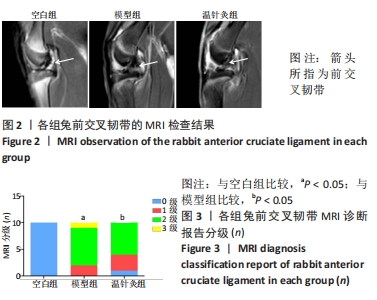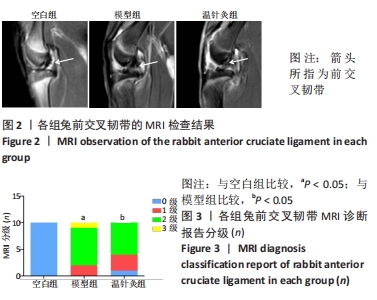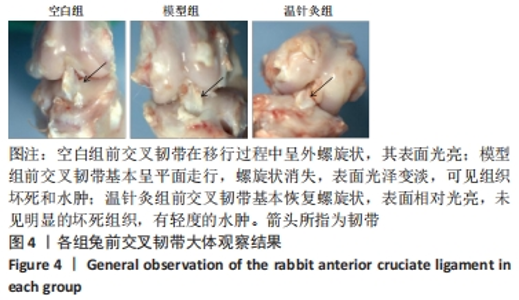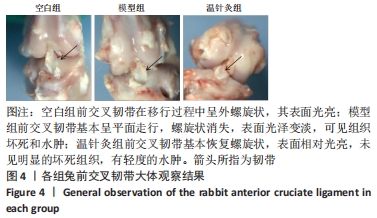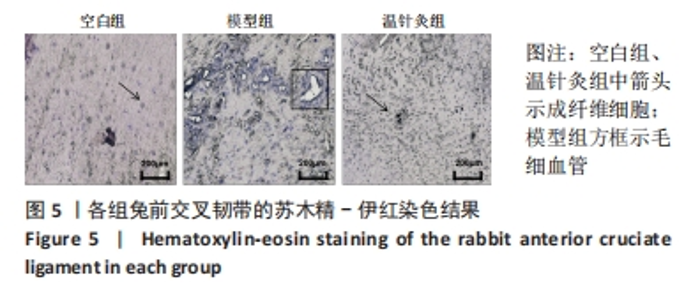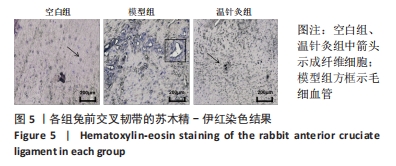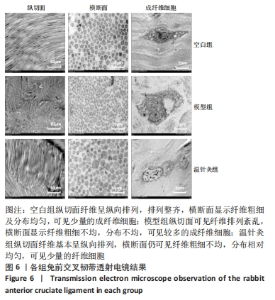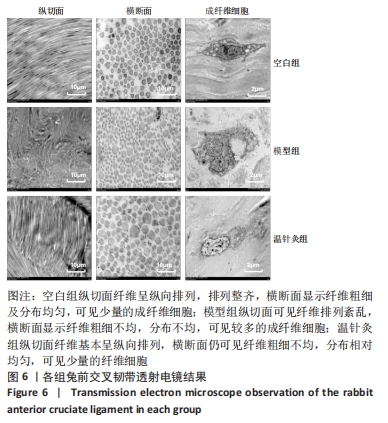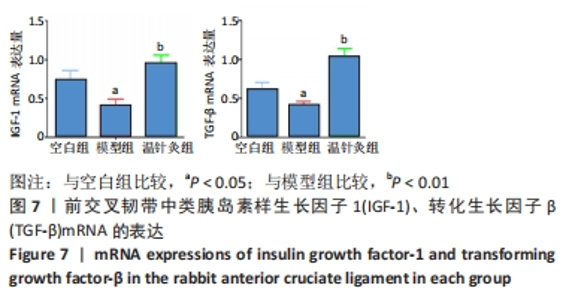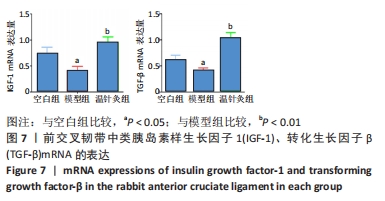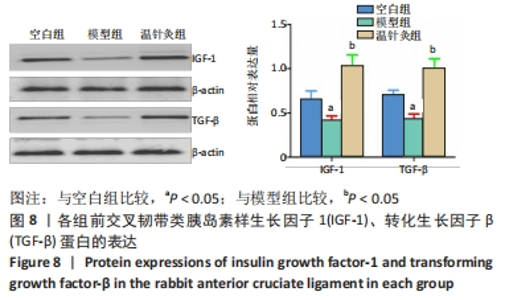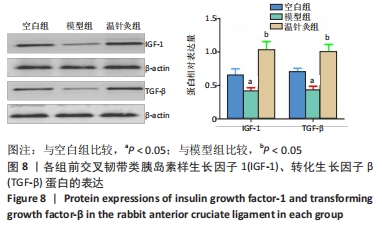[1] 冯明利.骨关节炎发病机制研究进展[J].北京医学,2015,37(4):372-374.
[2] 方剑利,楼红侃,金甬,等.补肾通络法治疗膝关节骨性关节炎肾虚血瘀证的临床疗效及对骨代谢指标的影响[J].中华中医药学刊, 2022,40(7):82-86.
[3] RAMME AJ, LENDHEY MS, STRAUSS EJ, et al. A biomechanical study of two distinct methods of anterior cruciate ligament rupture, and a novel surgical reconstruction technique,in a small animal model of posttraumatic osteoarthritis. J Knee Surg. 2018;31(1):43-49.
[4] 李美.老年女性膝关节骨关节炎患者前交叉韧带中机械感受器变化的研究[D].石家庄:河北医科大学,2015.
[5] 严浩.骨关节炎关节退变对前交叉韧带力学性质的影响[D].大连:大连医科大学,2022.
[6] 刘佳.前交叉韧带损伤后软骨退变和骨性关节炎发生的分子变化[J].基因组学与应用生物学,2020,39(1):394-401.
[7] MOLLOY T, WANG Y, MURRELL G. The roles of growth factors in tendon and ligament healing. Sports Med. 2003;33(5):381-394.
[8] WOO SL, ABRAMOWITCH SD, KILGER R, et al. Biomechanics of knee ligaments: injury, healing, and repair. J Biomech. 2006;39(1):1-20.
[9] 张艳玲,刘君伟,李春,等.基于JAPK2/STAT3信号通路探讨温针灸改善膝关节骨关节炎兔软骨损伤的机制[J].针刺研究,2022, 47(12):1088-1094.
[10] 武永利,陈人智,王明磊,等.温针灸对膝骨性关节炎兔软骨及软骨下骨形态学的影响[J].针刺研究,2021,46(2):123-128.
[11] 罗彬,刘泉.内侧半月板部分切除联合前交叉韧带切断的大鼠膝关节炎模型研究[J].蚌埠医学院学报,2017,42(12):1585-1588.
[12] 熊勇,张照庆,夏数数,等.改良伸直位固定法建立兔膝骨性关节炎模型的研究[J]. 湖北中医学院学报,2010,12(5):19-21.
[13] 李忠仁.实验针灸学[M].北京:中国中医药出版社,2013:327.
[14] 李浩,徐子军,汤光宇,等. MRI膝关节功能位对退行性膝关节炎患者前交叉韧带附着端早期损伤的评价[J]. 中国中西医结合影像学杂志,2017,15(1):41-44.
[15] 董青青,赵勇,张宽.筋骨并重理论在骨折康复中的应用思考[J].中国中医药信息杂志,2016,23(5):107-108.
[16] 李胜,李金松,阎伟.基于数据挖掘技术分析针灸治疗膝骨关节炎的选穴规律[J].中国中西医结合影像学杂志,2021,19(3):210-216.
[17] 谢洪华.膝骨关节炎前交叉韧带退变的研究进展[J].风湿病与关节炎,2022,11(8):72-76.
[18] 孙亚东,祝丽敏. CT、MRI与MRI不同序列对膝关节外伤后前后交叉韧带损伤的诊断价值[J]. 临床医学研究与实践,2023,8(8):82-84,117
[19] 薛安晓,杨灵芝.17°微屈位及 30°屈曲位膝关节磁共振成像对膝关节外伤患者前交叉韧带断裂的诊断价值[J].实用医学影响杂志, 2022,23(4):415-418.
[20] 黄竞敏,胡文晋,李冬超,等.前交叉韧带退变与髁间窝撞击及内侧半月板撕裂的相关性研究[J].中国修复重建外科杂志,2016, 30(12):1478-1482.
[21] LOUBOUTIN H, DEBARGE R, RICHOU J, et al. Osteoarthritis in patients with anterior cruciate ligament rupture:a review of risk factors. Knee. 2009;16(4):239-244.
[22] RAHIM M, MANNION S, KIUG B, et al. Modulators of the extracellular matrix and risk of anterior cruciate ligament Ruptures. J Sci Med Sport. 2017;20(2):152-158.
[23] HASEGAWA A, NAKAHARA H, KINOSHITA M, et al. Cellular and extracellular matrix changes in anterior cruciate ligaments during human knee aging and osteoarthritis. Arthritis Res Ther. 2013;15(1):R29.
[24] RUSCHKE K, MEIER C, ULLAH M, et al.Bone morphogenetic protein 2/SMAD signalling in human ligamentocytes of degenerated and aged anterior cruciate ligaments. Osteoarthritis Cartilage. 2016;24(10): 1816-1825.
[25] KOBAYASHI K, YAMAZAKI M, HONDA T, et al. Effect of insulin-like growth factor 1 and basic fibroblast growth factor on DNA synthesis and collagen production in cultured anterior cruciate ligament cells. J Orthop Sci. 1997;2(5):349-356.
[26] SHAO HJ, LEE YT, CHEN CS, et al. Modulation of gene expression and collagen production of anterior cruciate ligament cells through cell shape changes on polycaprolactone/ chitosan blends. Biomaterials. 2010;31(5):4695-4705.
[27] XIE J, WANG C, HUANG DY, et al. TGF-beta1 induces the different expressions of lysyl oxidases and matrix metalloproteinases in anterior cruciate ligament and medial collateral ligament after mechanical injury. J Biomech. 2013;46(12):890-898.
[28] PASCHER A, STEINER TAF, PALMER GD, et al. Enhanced repair of the anterior cruciate ligament by in situ gene transfer: evaluation in an vitro model. Mol Ther. 2004;10(2):327-336.
[29] 李连华.注射重组转化生长因子-β1和胰岛素样生长因子-1基因治疗骨关节炎的实验研究[D].北京:中国协和医科大学,2006.
[30] VEBRUGGEN G. Chondroprotetive drug in degenerative joint diseases.Rheumatology(Oxford). 2006;45(2):129-138.
[31] 沈雁,陈鸿辉,李贤让,等.成纤维细胞生长因子和表皮生长因子及复合因子对兔ACL、MCL体外增殖作用[J].中国修复重建外科杂志,2005,19(3):229-233. |
